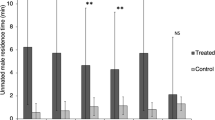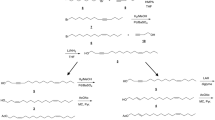Abstract
The sex pheromone of the pear moth, Cydia pyrivora, is (E,E)-8,10-dodecadien-yl acetate. A 5%-addition of the geometric isomers E,Z and Z,Z decreased male attraction in the field, the Z,E isomer had no significant effect. Traps baited with 10 µg E,E on grey rubber septa were attractive throughout the flight period of C. pyrivora. These traps allow specific detection of pear moth, and they are not attractive to its sibling species, codling moth C. pomonella.
Similar content being viewed by others
References
Arn, H., S. Rauscher and A. Schmid, 1979. Sex attractant formulations and traps for the grape moth Eupoecilia ambiguella Hb. Mitt. Schweiz. Entomol. Ges. 52: 49–55.
Arn, H., P.M. Guerin, H.-R. Buser, S. Rauscher and E. Mani, 1993. Sex pheromone blend of the codling moth, Cydia pomonella: evidence for a behavioural role of dodecan-1-ol. Experientia 41: 1482–1483.
Bovey, P., 1966. Super-famille des Tortricoidea. In: A.S. Balachowsky (ed), Entomologie Appliquée à l'Agriculture, Vol. II. Masson, Paris. pp. 456–893.
Brown, D.F. and L.M. McDonough, 1986. Insect sex pheromones: formulations to increase the stability of conjugated dienes. J. Econ. Entomol. 79: 922–927.
Danilevskij, A.S. and V.I. Kuznetsov, 1968. Listovertki Tortricidae: triba plodozhorki Laspeyresiini. In: Fauna SSSR, Nasekomye Tcheshuekrylye, Vol. 5. Nauka, Leningrad.
Davis, H.G., L.M. McDonough, A.K. Burditt, Jr. and B.A. Bierl-Leonhardt, 1984. Filbertworm sex pheromone. Identification and field tests of (E,E)-and (E,Z)-8,10-dodecadien-1-ol acetates. J. Chem. Ecol. 10: 53–61.
Einhorn, J., F. Beauvais, M. Gallois, C. Descoins and R. Causse, 1984. Constituants secondaires de la phéromone sexuelle du carpocapse des pommes, Cydia pomonella L. (Lepidoptera, Tortricidae). C. R. Acad. Sc. Paris 299(III): 773–778.
George, D.A., L.M. McDonough, D.O. Hathaway and H.R. Moffitt, 1975. Inhibitors of sexual attraction of male codling moths. Environ. Entomol. 4: 606–608.
Greenway, A.R. and C. Wall, 1981. Attractant lures for males of the pea moth, Cydia nigricana (F.) containing (E)-10-dodecen-1-yl acetate and (E,E)-8,10-dodecadien-1-yl acetate. J. Chem. Ecol. 7: 563–574.
Hathaway, D.O., T.P. McGovern, M. Beroza, H.R. Moffitt, L.M. McDonough and B.A. Butt, 1974. An inhibitor of sexual attraction of male codling moths to a synthetic sex pheromone and virgin females in traps. Environ. Entomol. 3: 522–524.
McDonough, L.M., R.D. Eikenbary, M.T. Smith, H.G. Davis, C.L. Smithhisler, G.A. Hedger, R.K. Campbell, J.A. Payne, W. Reid and J.R. McVay, 1990. Sex pheromone of hickory shuckworm Cydia caryana. Development of an effective field lure. J. Chem. Ecol. 16: 317–324.
Pashley, D.P., 1983. Biosystematic study in Tortricidae (Lepidoptera), with a note on evolutionary rates of allozymes. Ann. Entomol. Soc. Am. 76: 139–148.
Priesner, E., 1980. Sensory encoding of pheromone signals and related stimuli in male moths. In: Insect Neurobiology and Insecticide Action (Neurotox 79). Soc. Chem. Ind., London. pp. 359–366.
Roelofs, W.L., A. Comeau, A. Hill and G. Milicevic, 1971. Sex attractant of the codling moth: characterization with electroantennogram technique. Science 174: 297–299.
Streinz, L., A. Horak, J. Vrkoc and I. Hrdy, 1993. Propheromones derived from codlemone. J. Chem. Ecol. 19: 1–9.
Witzgall, P., M. Bengtsson, C.R. Unelius and J. Löfqvist, 1993. Attraction of pea moth Cydia nigricana F. (Lepidoptera: Tortricidae) to female sex pheromone (E,E)-8,10-dodecadien-1-yl acetate, is inhibited by geometric isomers E,Z, Z,E and Z,Z. J Chem. Ecol. 19: 1917–1928.
Witzgall, P., A.-C. Bäckman, M. Svensson, M. Bengtsson, C.R. Unelius, J. Vrkoc, P.A. Kirsch, C. Ioriatti and J. Löfqvist, 1996a. Potential of a blend of E8,E10–12OH and E8,E10–12Ac for mating disruption of codling moth Cydia pomonella L. (Lepidoptera, Tortricidae). J. Appl. Ent. 120: 611–614.
Witzgall, P., J.-P. Chambon, M. Bengtsson, C.R. Unelius, M. Appelgren, G. Makranczy, N. Muraleedharan, D.W. Reed, K. Hellrigl, H.-R. Buser, E. Hallberg, G. Bergström, M. Tóth, C. Löfstedt and J. Löfqvist, 1996b. Sex pheromones and attractants in the Eucosmini and Grapholitini (Lepidoptera, Tortricidae). Chemoecology 7: 13–23.
Witzgall, P., C.R. Unelius, F. Rama, P.-J. Chambon and M. Bengtsson, 1997. Mating disruption of pea moth, Cydia nigricana, and codling moth, C. pomonella, using blends of sex pheromone and attraction antagonists. In: P. Witzgall and H. Arn (eds), Technology Transfer in Mating Disruption. IOBC WPRS Bulletin Vol. 20(1). Avignon, pp. 207–215.
Author information
Authors and Affiliations
Rights and permissions
About this article
Cite this article
Makranczy, G., Tóth, M., Chambon, JP. et al. Sex pheromone of pear moth, Cydia pyrivora. BioControl 43, 339–344 (1998). https://doi.org/10.1023/A:1009983613234
Issue Date:
DOI: https://doi.org/10.1023/A:1009983613234




